MAKE SURE YOU CONTINUE TO RECEIVE EACH ISSUE OF TUESDAY MARKETING NOTES—CLICK HERE TO RENEW YOUR FREE SUBSCRIPTION
Starting Smart: Using Small Print Ad Formats to Generate Big Sales Response for New Product Launches and Marketing Programs (Part 1)
by Eric Gagnon
This week, let’s address the art and craft of producing small ads that generate solid sales response.
As discussed in TMN 138 (accessible here), the answer to every print advertising problem isn’t always a full page ad. In fact, unless you’re with a big company that needs to maintain its brand image, let’s say, where key accounts and your competitors more or less expect you to be running full page advertising, your default position on print advertising ought to be “Think Small:” Start with the smallest effective ad size rather than with a full-page ad.

Why Think Small?
Aside from cost, why run small ads? If your goal in marketing is to generate sales leads for your company’s (or client’s) sales team—and this is what most of us in B2B marketing do—a small ad using an actionable offer is the most cost-efficient way to generate sales leads.
Small ads also work extremely well for “Rolodex card businesses:” Companies offering products or services that other companies may need on a sporadic basis. Examples would include engineering services, technical consulting, maintenance equipment, repair services, replacement parts, etc. With these kinds of businesses, prospects only need your services when they need them—for example, a company with a unique engineering problem or a plant maintenance issue that suddenly occurs in its operation. If you’re running marketing for a company like this, you can run fractional-space ads in every issue to keep your company and its product or service offering in front of your market, so readers can find your company when they need your product or service.
While generating sales response is the best use of running small ads, you can also run smaller ads to keep your company’s name and product or service in front of your market. While you may derive some “brand awareness” benefits from these ad programs, you’ll find them hard to measure in any way your company’s CFO will take seriously.

Which Fractional Ad Size is Best?
The best ad size is one that generates the most sales response with the lowest cost and, most important—with the lowest risk of financial loss. And given the potential high risk of running money-losing print advertising programs, when selling your product or service into a new market, you want to move carefully and incrementally into a print advertising program to keep your risk to a minimum.
You can make just about any fractional ad size into an effective sales-lead producing powerhouse for your marketing program. Half-page, quarter-page, even smaller eighth-page ad sizes can be optimized to generate excellent sales response.
For market launches, the best ad size is the smallest size which allows you to run at least three insertions in the leading trade publication for your industry. If you have a larger budget, you can also run in the second-largest publication, but if you go beyond the top two publications in an industry too soon, you risk letting your unproven advertising program get out of control. Better to get your sales messaging and promotions dialled in with a reduced ad program and other marketing methods before running a big ad program right out of the gate. After three insertions (and usually before), you’ll know whether or not the ad is pulling, or if print advertising is even a viable part of your marketing program.
Presentation and Layout: The “Story to Offer” Ratio
Once you’ve decided on the ad size you want to run for your launch, sketched out the benefits and copy for the key elements of your ad, and developed the offer you want to use in your ad, the next step is producing the content and layout of your ad—or guiding this process if the copy and layout of your ad will be written and designed by your agency, marketing consultant, or layout designer.
The content of every fractional-size ad contains two major characteristics:
• The “story,” or your description of your product, its benefits, and why these benefits are compelling to your reader, and
• The “offer,” the token of exchange you are offering to your prospect in exchange for their interest, and for taking the time to contact you and give you their contact information
Larger fractional ad sizes allow you to tell more or your “story;” i.e., to present your product and communicate its essential benefits, before presenting your “offer”—the discount, free offer, or information premium you are offering to induce the reader to take action now to contact your company.
This “story to offer” ratio varies as the size of the page decreases. With a larger fractional page size, you can fill more “story” detail in on your company and product benefits, but as the page size decreases, so does the amount of real estate you have left in your layout to tell your story. So, with a smaller fractional ad sizes, you are better off putting more emphasis on presenting your offer, summarizing just enough of your story to give your reader the background they need to decide on your offer.
Sketching out Sales Copy Benefits for Fractional Page Ads
Now let’s go through the process of producing a fractional ad. Even if you’re not writing or producing your fractional ads, it’s important for you to know the process so you can spec out an ad for your ad agency or consultant by creating a sales copy outline to help them along in the process.
Start by sketching out your product’s major benefits—since you’re working in a fractional size, you have a limited amount of space, so you want to press hard on the major benefit statement that will draw readers of that publication into your ad.
In our example, let’s produce an ad for a hypothetical company selling oilfield monitoriing and control systems for oil drilling operations. This company sells a system which uses a network of sliding valve sleeves tied to a single computer control station that allows the operator to more efficiently monitor and control multiple oil reservoirs tapped by a single pipeline.
The challenge with this product is using a fractional page ad to motivate a muddy-boots oilfield engineer who’s flipping through a petroleum engineering publication to read our ad, and getting them to contact our client.
Key product benefits: The company‘s major benefits are that its system is more economical and more reliable than competitive systems, and the design of its system shortens the length of time it takes to detect and respond to “downhole” changes in multiple oil wells, which increases efficiency and productivity in certain types of oil fields.
This company has a great product, and an extensive real-world track record to back up its product benefits. In fact, the company has many documented success stories telling how its products increase oilfield yields through greater efficiency and productivity. Better yet, the company can show hard, verifiable numbers documenting the yield improvements in fields where its systems are in operation.
As a marketer, you can’t get a better product to sell than one whose benefits can be documented in a hard, quantifiable way. If you can demonstrate and quantify your product’s improved performance over the way potential prospects currently run their operations, or against competitive products, then you’re more than halfway to getting the information you need to create highly effective sales copy for your ad that presents your product’s most compelling benefit. This, of course, is based on the assumption that the most compelling benefit is the greater revenue resulting from increased productivity, which it most always is.
Let’s start by sketching out the major benefits of this product:
• Shorter detection and response times, leading to:
• Increased efficiency and productivity;
• More economical and reliable than competitive systems
For purposes of this example, we’ll assume these are solid benefits for our product. However, in an actual marketing project we would go through a de-briefing of the company’s sales reps to help us verify these benefits (or uncover new and even better benefits), and the Three-Step Copywriting Exercise, to help us document all the possible benefits of this product. See the bottom of this article for links to these previous issues of TMN on these topics.
Elements of a Fractional-Page Ad
Fractional-page ads share the five key elements of full-page ads, but due to their reduced size, there a few important exceptions to bear in mind for each of these elements:
Headline:
The headline, and the headline combined with a product shot or applications shot of your product or service, is the most important element of a fractional ad, since it’s the first thing most readers see when they’re flipping through a publication. A headline can be one word or it can be twenty or more words, but its only purpose is to stop the reader and get them to read the rest of your ad. If your headline does this, then it passes the focus of the reader’s attention to the other elements of your ad—subhead, body copy, and call-to-action.
A very effective device for making fractional ads jump off the page is to set headlines in big, bold type; the more you exaggerate this effect, the more attention-getting your ad will be. We’re not trying to win ad design awards here—we are working to generate sales response for our companies and clients!
Headlines for smaller fractional ads have fewer words than for larger fractionals, and you’ll see this as we produce a smaller sized eighth-page variant from our quarter-page example next week.
Subhead:
A bold-faced subhead, set below your headline, fills in more detail on your product’s main benefit and serves as a transition element between your headline and the body copy of your ad. However, since most readers won’t read your ad entirely, you should write heads and subheads so they communicate the essential description and reason-to-buy benefits of your product when they are read all by themselves. Most readers will see your headline, stop, read the subhead, and then move to your call-to-action offer, where they’ll decide whether or not to take action to contact your company.
Body Copy:
In a fractional ad, there’s usually not much space left for more than a short paragraph of body copy, which fills in the rest of your product’s essential product benefits. In smaller fractional ads, you can produce a more effective ad by replacing this body copy paragraph with a handful of one-line sales copy bullet points.
Call-to-Action:
Unless you are running fractional ads designed merely to promote awareness of your company, your ad will need a strong “call-to-action” to get readers to contact your company. This means making an offer to your reader of something that’s valuable enough to get your reader to contact you and give you their name, email address, or phone number in exchange for what you give to them—usually, this is a special offer or other inducement, such as a free informational premium to move the reader to contact your company. This is the “offer” part of your fractional ad.
Logo and Contact Info:
Last, and very important, is your company’s logo and contact info, set big and bold enough to make it easy for people to contact you. When producing fractional ads, make sure a reader can see this information plainly on your ad.
As you reduce the size of your ad, each of these elements are reduced in turn, shifting the “story/offer ratio” in favor of the “offer” over the “story.” The skill of producing effective fractional ads is in knowing how to reduce these elements without unduly diminishng the pulling power of your layout—and that’s what we’ll cover next week.
Here are some additional links from previous issues of Tuesday Marketing Notes you may find useful for print advertising projects for new market launches:
Targeting a New Market (Part 6: Five Keys to Starting Smart with a Print Advertising Program in Your New Market Launch—1)
Getting Better Sales Copy: Three-Step Sales Copy Outline Exercise for Marketing Managers
Ugly Little Ads that Sell: How to Make a Smaller Ad Pull Better Than a Bigger One
Next week: The craft of effective layout for fractional-page ads that
generate sales response . . .
Comments? Questions? Send them to me at: eric@businessmarketinginstitute.com
Eric Gagnon (eric@businessmarketinginstitute.com), a director with the Business Marketing Institute, is author of The Marketing Manager’s Handbook and The CRM Field Marketing Handbook.









